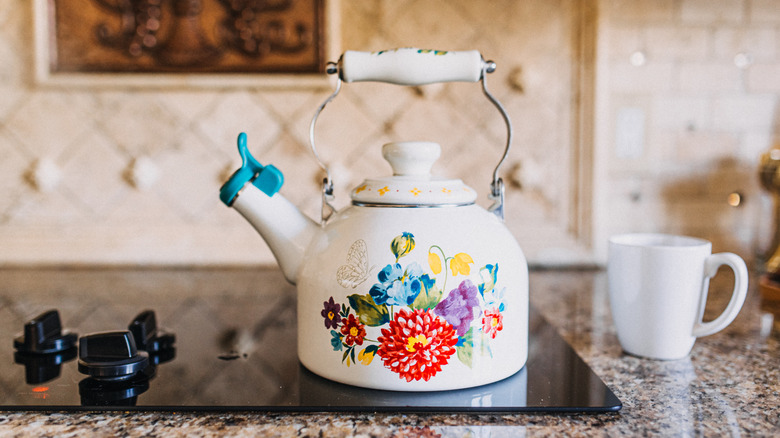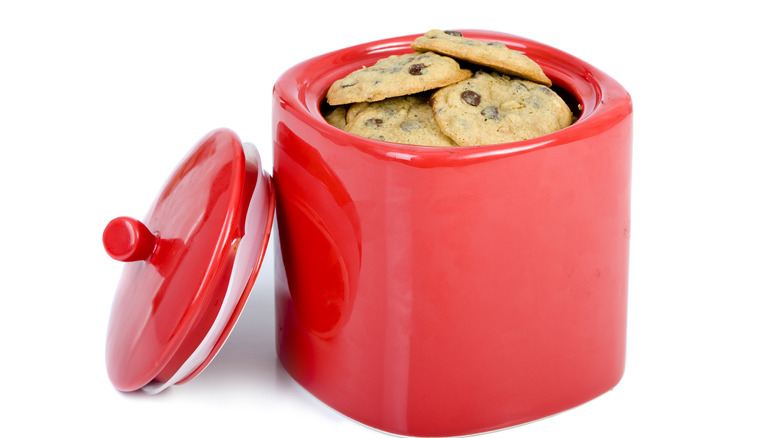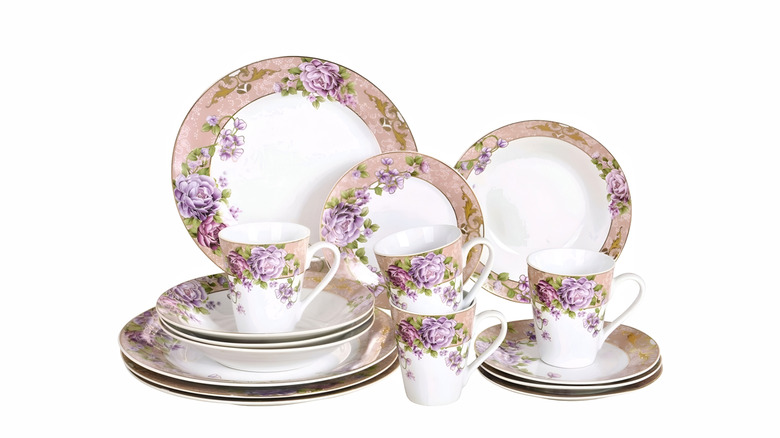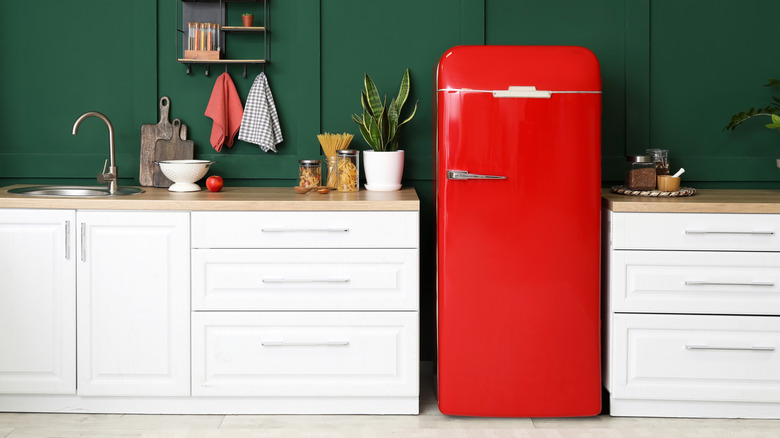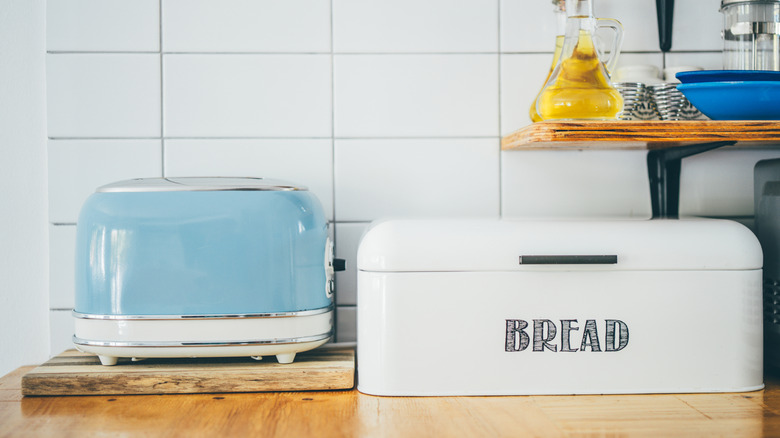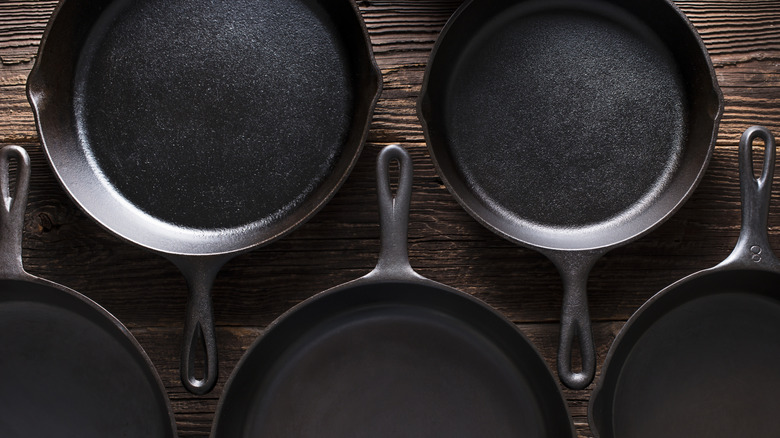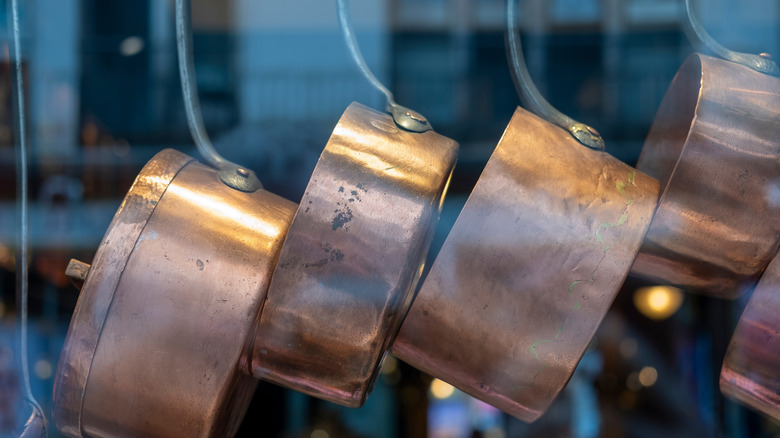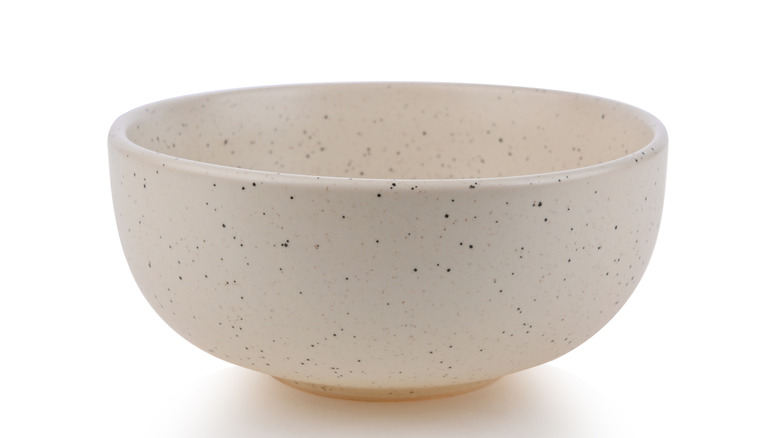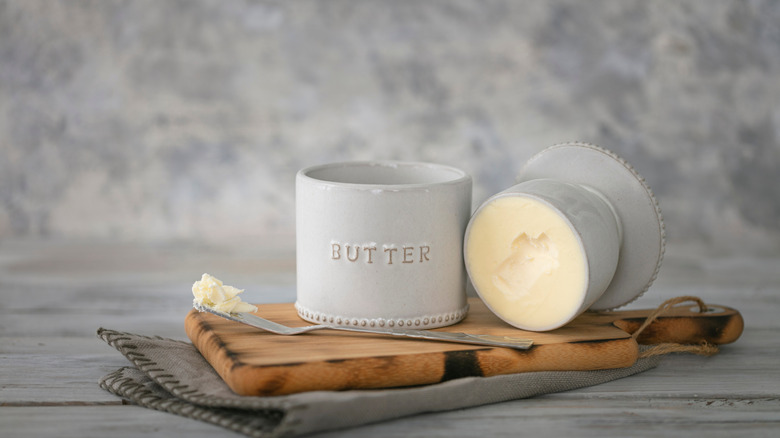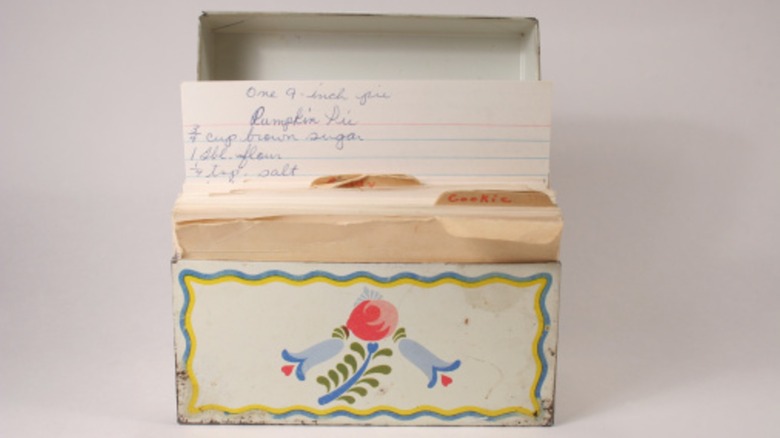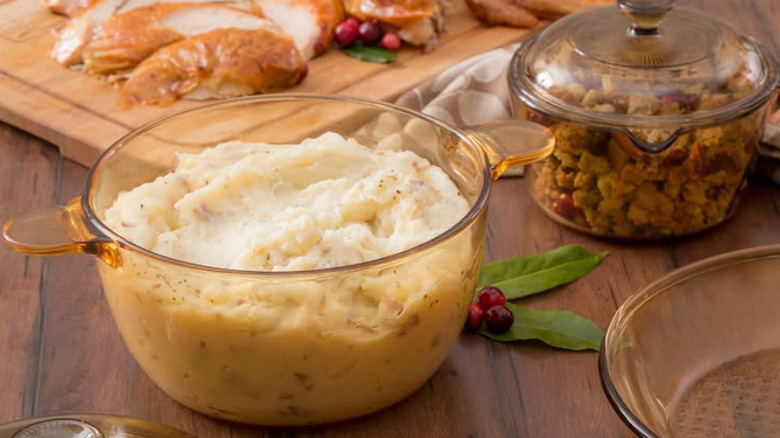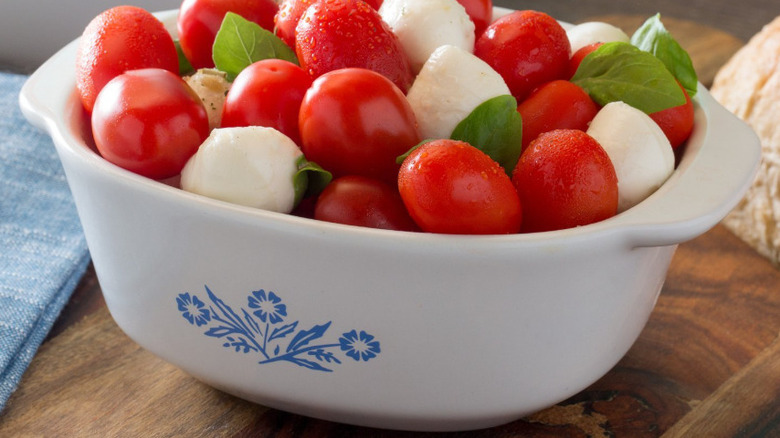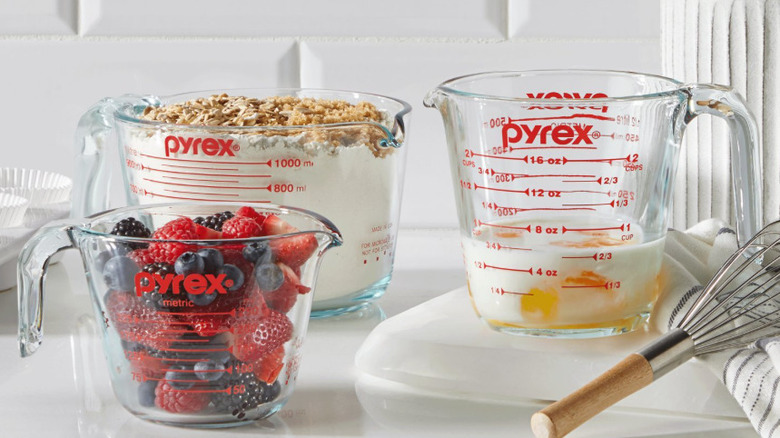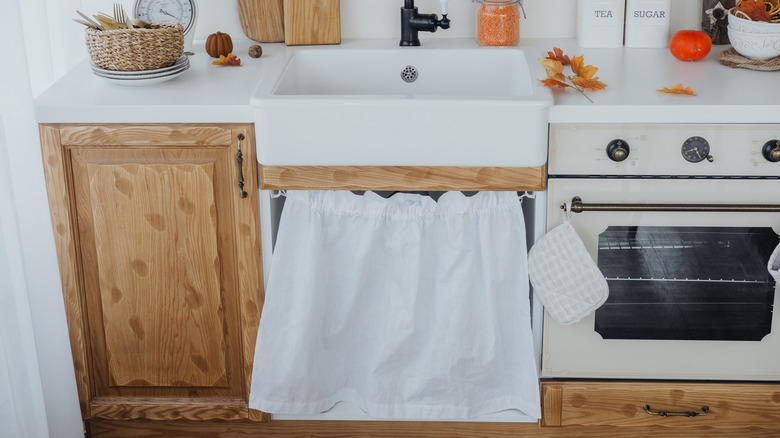13 Old-School Kitchen Items That Are Making A Comeback
After years of seeing industrial and minimalist themes reign in residential interior design, it's refreshing to witness people fall in love again with old-school kitchens. If your social media algorithm skews toward food, home, and interior design content, you'll have noticed that vintage kitchen appliances, old ceramic dishes, and grandma-core cooking tools are once again popular.
This trend is unsurprising given the current state of our world. With news about political upheavals and worries about economic crises beating down on us daily, all on top of our responsibilities at work and home, it's only natural that people would turn to things that can give them warmth and comfort.
Old-school kitchens with their charming bits and bobs offer exactly that. They are nostalgic, making us remember happy times as young kids unburdened by things like rent and high prices of groceries. But apart from the escapism brought about by nostalgia, vintage kitchen items have incredible functionality and durability that rival their modern counterparts. So, when thrifters find rare and vintage items that fit the cottage-core kitchen aesthetic or people receive old kitchen appliances as gifts from friends and relatives, they get excited, share them on social media, and get thousands of others hyped about these vintage finds. Here are 13 old-school kitchen items that are coming back in popularity.
1. Ceramic cookie jars
You can't get more old-school than vintage (or at least vintage-inspired) ceramic cookie jars. These adorable jars — usually in cute animal shapes, floral prints, or featuring a cover with a seasonal design or iconic cartoon character — bring back memories of sneaking in the kitchen and lifting the lid ever so carefully, making sure not to make too much noise as you sneak a cookie or muffin that mom or grandma baked just that morning. It's a precious memory that everyone deserves to experience.
And it looks like the younger crowd is game for such experiences. There's been a noticeable uptick in uploads of reels and stories of people excitedly sharing their new purchases or thrift store finds of vintage cookie jars with lids. The Mother Goose cookie jar that was popular in the '80s, in particular, is a current crowd favorite.
Ceramic cookie jars merge function and aesthetic effortlessly. Sure, they can't make cookies last very long (cookies in these jars stay moist for about two to three days) but that's part of their charm: the cookies are supposed to be eaten right away. They're made for sharing and enjoying after a tiring day. That's the sentiment behind ceramic cookie jars.
2. Vintage dinnerware
Although minimalist white or gray dinnerware is still trendy, many are becoming fond of colorful vintage dinner plates, appetizer plates, serving plates, and bowls. If they come in matching sets? Even better.
Vintage dinnerware sets are elegant and nostalgic, hinting at an era when people dressed to the nines for dinners that lasted for hours. They are eye-catching, often bearing designs that reflect the trendy art movement or style of the age. The 1920s, for example, saw Art Deco designs on dinner plates, while the '50s to '60s saw the rise of kitsch patterns on famous brands like Pyrex.
Vintage dinnerware sets are perfect for table setting, adding sophistication to otherwise ordinary dinners at home. A word of warning, however: not all vintage dinnerware is safe for eating.
Dinnerware made before 1971 may have used inks containing leachable lead (and in the case of Fiestaware, detectable radioactive material). It wasn't until 1971 that the U.S. Food and Drug Administration enforced guidelines against the use of inks with leachable lead on vintage dinnerware. So, if there's no way to verify that a vintage dinnerware set was made after 1971, or that its manufacturer did not use lead inks, it's best to put them on display in your dining room instead of using them to serve food in.
3. Retro refrigerators
For those who follow cottage-core interior design and food content channels on social media, the sight of a retro refrigerator in a fully functional kitchen is no longer new. They're very popular today, thanks to their attractive colors (usually in soft shades of pastel), distinctive round edges, shiny chrome handles, and the way they seamlessly fit in with rustic style, contemporary, and minimalist-industrial homes.
Vintage refrigerators also have interesting features that make them more appealing. A 1956 Frigidaire commercial went viral on social media a few months ago because of how purposeful its features were compared to modern-day refrigerators. The ad showcased a clear, detachable hydrator compartment for fruits and vegetables; a tiny, dedicated compartment for spreadable butter; sturdy, pull-out shelves that slide out smoothly even when full; and a large freezer boot that also has pull-out shelves. That ad got many people dreaming of their own vintage refrigerator.
Sadly, not everyone gets to inherit well-maintained appliances from their grandparents or find vintage General Electric fridges from the '50s. But if you're after the retro aesthetic and prefer safe, energy-efficient, modern refrigerators, brands like Smeg, Elmira, and Big Chill are popular alternatives.
4. Pastel-colored vintage appliances
Refrigerators are not the only kitchen appliances that many like to see in retro form. Small appliances like toasters, coffee makers, blenders, hand mixers, kettles, and ovens that are vintage or vintage-inspired are also making a comeback.
It's hard to pinpoint exactly when the trend started, but the last five years saw a gradual shift in preferences for kitchen decor. Many set aside the industrial, smart-kitchen look in favor of the warmer, cozier vibes of a cottage-core kitchen. It started with lace table runners and tea coasters, floral tablecloths, wildflowers in repurposed bottles, pottery jars, and fresh fruits in woven baskets until, finally, the vintage appliances made their way back to our kitchens.
Smeg's vintage kitchen appliances immediately come to mind. You see them everywhere now, in appliance centers, shopping malls, bazaars for household appliances, and also on social media. They look lovely lined up on a kitchen counter with their matching colors and distinctive design elements like chrome logos and widely rounded edges. They are undeniably aesthetically pleasing, making millennial and Gen Z consumers dream of owning a complete, matching kitchen appliance set someday.
5. Cast iron pans and skillets
For people who only cook perfunctory dishes and aren't interested in heavy-duty, commercial kitchen-grade cooking implements, cast iron pans, and skillets are additional old-school kitchen items that are now popular again. But it's the opposite for chefs and people who love cooking at home. Cast iron is beloved for its impressive heat retention, which means food cooks evenly and stays warm long in these pans. Sadly, cast iron pans are often passed over for ceramic or stainless steel cookware because they are high-maintenance and require a lot of prep before you can cook on them.
You have to season cast iron pans properly and regularly to prevent rusting. You also cannot use dishwashing soap on a cast iron pan, much less put it in the dishwasher. Doing so will strip the oil coating from the pan, and you'll have to season it all over again.
But despite the time and effort required for maintaining cast iron cookware, it appears that many are now willing to invest in it. Many use cast iron now, not just chefs. Years after nonstick pans hogged and later lost the spotlight following the news that they contain toxic substances, cast iron's renewed popularity is well deserved.
6. Bronze cookware
Bronze cookware is common in Asian countries like India, where it's called "kansa," and Korea, where the locals refer to it as "yugi." These pans have been widely used in these countries since the Bronze Age. Although many now prefer modern cooking pans, there are still families that meticulously care for their heirloom bronze cookware and use it to cook special meals.
Bronze cookware is not to be confused with brass. Both may be popular on social media these days, but they are different in appearance and composition. Bronze is an alloy made from copper and tin, and it appears more matte-gold. Brass, on the other hand, is made from copper and zinc — it is highly reflective and has a brighter, golden sheen.
Bronze cookware is non-leachable and safer to use for cooking than brass, which requires a tin coating for it to be resistant to acidic food. It retains and conducts heat very well, so it cooks food evenly. Unsurprisingly, bronze is the choice cookware for Ayurveda cooking, as it is believed to retain 97% of food's nutritional value.
7. Vintage stoneware mixing bowls
Steel mixing bowls are common in today's kitchens. However, they are rather sterile and unexciting compared to stoneware mixing bowls.
Vintage stoneware bowls have so much character, from their bright colors and shiny glaze to some charming design elements like handpainted detail or intricate cane boning on the outside of the pottery. They need more maintenance and care than steel mixing bowls, but nothing as hardcore as caring for cast iron pans. They come in all shapes and sizes, and some have practical details like extended sections on the rim to serve as hand grips. The shape of a vintage stoneware bowl can also get interesting, like having a round rim and body that morph into a square base.
Perhaps it's because of cottage-core's current popularity that vintage stoneware bowls are popular again, or people today simply like to add rustic charm and nostalgia in their homes. Regardless, bowls are one of the most economical ways to do it. It's lovely to see these bowls see the light of day again, proudly displayed on open shelves instead of stowed out of sight along with the old, battered kitchen things we neither use nor throw away.
8. Butter bells or butter crocks
Lately, there's been an influx of videos of people discovering French butter bells and how they work uploaded on social media. Since many haven't seen these clever things before, the comments are usually filled with people awed and amazed that one can have spreadable butter anytime, all the time.
Butter bells, also known as butter crocks, are ceramic containers for softened butter. It consists of two pieces: a larger cup and a smaller cup (usually conical) with a wide base. Softened butter is spooned inside the smaller cup, which then goes upside-down into the larger cup, the base sitting flush on the lip of the larger cup, serving as the lid.
When placed inside the larger cup, the rim of the smaller cup sits a couple of centimeters above the bottom of the inside of the larger cup. This leaves room for a little bit of clean water that would completely seal the smaller cup (the water should just touch the butter, not soak it). This keeps air and microorganisms from getting into the butter and spoiling it. Place the butter bell on your kitchen counter at room temperature, and the butter will stay fresh for up to a month. Now you won't have to take a whole block of butter from the refrigerator and thaw it just to get a few swipes on your toast.
9. Vintage recipe boxes
Thrifters and collectors of vintage items are usually thrilled to find personal mementos like photos or letters tucked between the pages of a book, a hidden compartment in an antique vanity desk, or kept lovingly in a keepsake box. These things evoke history and nostalgia, and may even reveal some heartwarming stories about the previous owners.
Vintage recipe boxes have the same nostalgic impact, more so if they have handwritten recipes on index cards or cutouts from old flour boxes, magazines, and recipe books. Since they come from a time when there was no internet to copy recipes off of, and people didn't have the luxury of bookmarking websites and cooking demos to be watched later, the recipes in these boxes are likely created through years of trial and error. The corrections written in different colored ink, superimpositions on the measurements, and cooking tips written on the cramped edges of the index cards, they all add to the charm of vintage recipe boxes.
Old recipe boxes are usually found in estate sales and bazaars. If you're lucky, you might inherit one from an older relative or friend. The boxes are a gem in and of themselves, but if they also bear prized family recipes handed down from grandparents and great-grandparents, that's a precious gift worth handing down to your children in the future.
10. Corning Visions cookware
Corning is a famous company known for its glass and ceramic dinnerware. It thrived since the 1950s and remains a respected brand for dinnerware. Corning has produced many beautiful collections of matching dinner plates, glasses, and bowls, but one of its most iconic lines of dinnerware is the Visions glass cookware.
The distinctive clear glass (Pyroceram) with a light brown tint comes in various forms of cookware, from shallow pans to bowls with hand grips. The best thing about Visions products is they have thermal shock resistance. This means they won't crack if you put them on a stove above an open fire while still cold from the fridge. Visions cookware is also nicely thick and heavy, and you can easily tell it is high quality.
Most Visions items are smooth and unadorned with prints or intricate designs. The covers or lids (also made from the same Pyroceram material) have a knob handle that is perfectly centered. You can flip the lid over and balance the entire thing on the knob like a cake stand. You can then use it as a plate, even as a skillet. Visions glassware is so versatile and functional, so its resurging popularity is well-deserved.
11. CorningWare cookware with blue cornflowers
If you're lucky, you might remember your mother or grandmother's prized CorningWare casseroles and bakeware. They come in different sizes and shapes but are usually white with a signature blue cornflower design. Large CorningWare pieces are usually square or round, and they have clear glass covers with knobs at the center. Each glass cover has an inner ring and a round or square border toward the edges. Everything looks simple but also, as proven over the years, classy and timeless.
CorningWare production started in 1953 and paused in 1990, then restarted 10 years later. Many brands have entered since then, but the brand remained popular from the '50s to the present. Mothers love their glassware and bakeware because they are so versatile and durable. You can use them for cooking on a gas stove, stick them in the oven to bake bread, or freeze leftover casseroles with them. Cooking with CorningWare is so convenient because you can take the dish from the stove or oven and put it right on the table. That's one less pan to wash after dinner!
Since CorningWare is made of glass and ceramics, it is safe to use for acidic food. The cornflower design uses safe ink, so there's no danger of chemicals leaching into the food. And since it's made for hot and cold temperatures, CorningWare doesn't easily break because of extreme temperature changes.
12. Pyrex measuring cups and glassware
Pyrex is another familiar name and was a mainstay in most kitchens until the late '90s. This beloved glassware was also made by Corning (then known as Corning Glass Works), back in 1915. The company used borosilicate glass, which gave the brand its recognizable clear, thick glass resistant to expansion and contraction due to extreme temperature changes. Simply put, Pyrex is incredible to cook or freeze soups and casseroles with.
Some of the most recognizable Pyrex pieces are the clear measuring cups with red markings and the dual-purpose clear casserole covers that can also be used as a serving dish. But there are also vintage Pyrex pieces that are solid white with red markings and designs. Some come with clear glass covers while others don't.
Pyrex glassware is timeless, and the vintage designs are even more precious because of their rarity and durability. If you need more proof about the quality of this glassware, Pyrex glass is used in making laboratory apparatus and equipment worldwide. It was even used in developing high-purity fused silica or HPFS glass, the purest in the world, that's now used in scientific telescopes.
13. Kitchen sink skirts
If you thought we were done mentioning cottage-core influences, you were wrong. On the surface, cottage-core is all about the aesthetics of rural living, balancing the comforts of modern homes with the coziness of a quaint cottage. But a closer, longer look at popular cottage-core accounts on social media hints at the collective yearning for something grounded and real, a place where people are allowed to take their time instead of being pressured to use technology to take shortcuts whenever and wherever possible.
It's a roundabout way of introducing the last item on this list: kitchen sink skirts. You might remember seeing one in your grandparents' kitchen: a piece of fabric hanging beneath the sink, covering the plumbing and other things stored in that cramped space. Sink skirts usually sport a bright, cheerful color and pretty patterns of fruits, animals, flowers, or geometric figures.
Kitchen sink skirts bring back memories of times when life was much simpler. That's the core of their appeal and the reason these old-school items are once again trendy.
